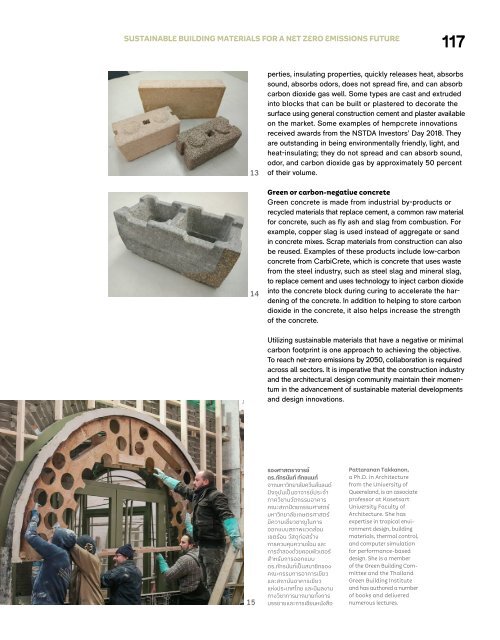ASA Journal 15/2023
You also want an ePaper? Increase the reach of your titles
YUMPU automatically turns print PDFs into web optimized ePapers that Google loves.
SUSTAINABLE BUILDING MATERIALS FOR A NET ZERO EMISSIONS FUTURE<br />
117<br />
13<br />
14<br />
perties, insulating properties, quickly releases heat, absorbs<br />
sound, absorbs odors, does not spread fire, and can absorb<br />
carbon dioxide gas well. Some types are cast and extruded<br />
into blocks that can be built or plastered to decorate the<br />
surface using general construction cement and plaster available<br />
on the market. Some examples of hempcrete innovations<br />
received awards from the NSTDA Investors’ Day 2018. They<br />
are outstanding in being environmentally friendly, light, and<br />
heat-insulating; they do not spread and can absorb sound,<br />
odor, and carbon dioxide gas by approximately 50 percent<br />
of their volume.<br />
Green or carbon-negative concrete<br />
Green concrete is made from industrial by-products or<br />
recycled materials that replace cement, a common raw material<br />
for concrete, such as fly ash and slag from combustion. For<br />
example, copper slag is used instead of aggregate or sand<br />
in concrete mixes. Scrap materials from construction can also<br />
be reused. Examples of these products include low-carbon<br />
concrete from CarbiCrete, which is concrete that uses waste<br />
from the steel industry, such as steel slag and mineral slag,<br />
to replace cement and uses technology to inject carbon dioxide<br />
into the concrete block during curing to accelerate the hardening<br />
of the concrete. In addition to helping to store carbon<br />
dioxide in the concrete, it also helps increase the strength<br />
of the concrete.<br />
Utilizing sustainable materials that have a negative or minimal<br />
carbon footprint is one approach to achieving the objective.<br />
To reach net-zero emissions by 2050, collaboration is required<br />
across all sectors. It is imperative that the construction industry<br />
and the architectural design community maintain their momentum<br />
in the advancement of sustainable material developments<br />
and design innovations.<br />
<strong>15</strong><br />
รองศาสต้ราจารย์<br />
ดร.ภัที่รนันที่์ ที่ักขนนที่์<br />
จากมหาวิทยาลัยควีนส์แลนด์<br />
ปั จจุบันเป็ นอาจารย์ประจำา<br />
ภาควิชานวัตกรรมอาคาร<br />
คณะสถาปั ตยกรรมศาสตร์<br />
มหาวิทยาลัยเกษตรศาสตร์<br />
มีความเชี่ยวชาญในการ<br />
ออกแบบสภาพแวดล้อม<br />
เขตร้อน วัสดุก่อสร้าง<br />
การควบคุมความร้อน และ<br />
การจำาลองด้วยคอมพิวเตอร์<br />
สำ าหรับการออกแบบ<br />
ดร.ภัทรนันท์เป็ นสมาชิกของ<br />
คณะกรรมการอาคารเขียว<br />
และสถาบันอาคารเขียว<br />
แห่งประเทศไทย และมีผลงาน<br />
ทางวิชาการมากมายทั้งการ<br />
บรรยายและการเขียนหนังสือ<br />
Pattaranan Takkanon,<br />
a Ph.D. in Architecture<br />
from the University of<br />
Queensland, is an associate<br />
professor at Kasetsart<br />
University Faculty of<br />
Architecture. She has<br />
expertise in tropical environment<br />
design, building<br />
materials, thermal control,<br />
and computer simulation<br />
for performance-based<br />
design. She is a member<br />
of the Green Building Committee<br />
and the Thailand<br />
Green Building Institute<br />
and has authored a number<br />
of books and delivered<br />
numerous lectures.

















